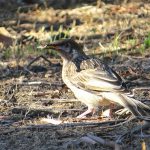RED WATTLEBIRD
The Red Wattlebird is a large and distinctive Australian honeyeater bird species belonging to the family Meliphagidae. It is known for its striking appearance and vocalizations.
It is a relatively large honeyeater, measuring around 32-37 cm in length. It has a predominantly grey-brown plumage with white streaks and spots on its chest and belly.
One of its most distinctive features is the red fleshy wattles that dangle from the sides of its neck, which are more prominent in males. The wings and tail feathers of the Red Wattlebird have a reddish-brown hue, which becomes more visible during flight.
The Red Wattlebird is native to south-eastern Australia, including regions like Victoria, New South Wales, South Australia, and Tasmania. These birds are adaptable and can be found in a variety of habitats, including forests, woodlands, heathlands, gardens, and urban areas. They are often seen in both urban and rural environments.
Red Wattlebirds are omnivorous and primarily feed on nectar from a variety of flowering plants. They have specialized brush-tipped tongues for efficient nectar extraction.
In addition to nectar, they also eat insects, fruits, and berries. Their diet can vary depending on the season and availability of food.
Red Wattlebirds are known for their loud and melodious calls, which can be quite varied and include a mix of whistles, clicks, and chattering sounds.
They are highly territorial and will defend their feeding and nesting areas aggressively, often engaging in aerial displays to deter intruders.
During the breeding season, they build cup-shaped nests in trees and shrubs. Breeding typically occurs from August to December. The female Red Wattlebird usually lays 2-3 eggs in the nest. Both parents take part in incubating the eggs and feeding the chicks.
Red Wattlebirds play an important role in pollination as they feed on nectar and transfer pollen between flowers while foraging. These birds are a fascinating part of Australia’s avian diversity and are easily recognizable due to their unique appearance and vocalizations. They contribute to the ecosystem by helping in the pollination of various plant species, making them an integral part of Australia’s natural heritage.










